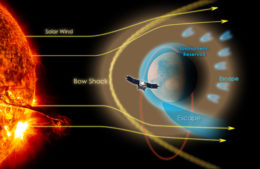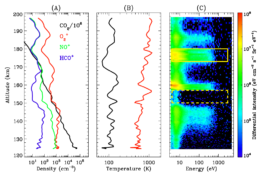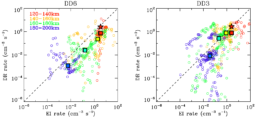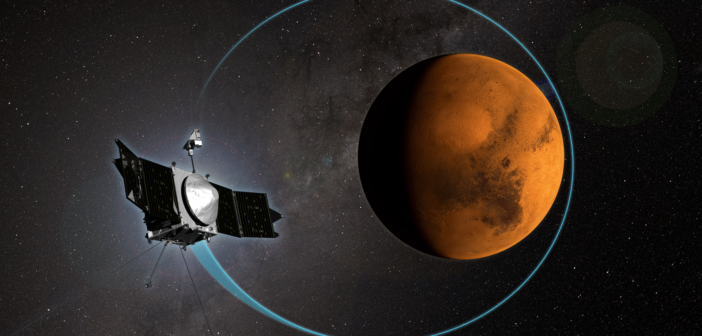When solar ultraviolet and X-ray photons collide with atoms and molecules in Mars’s atmosphere, they form a layer of plasma called an ionosphere. That’s what happens on the sunlit side, at least. What’s going on in Mars’s shadow?

A cartoon depicting the interaction of the solar wind with Mars’s atmosphere, as well as likely regions for atmospheric escape. [NASA/GSFC]
Planetary Plasma
Even though there are no solar photons striking Mars’s atmosphere at night, plasma is still present — but it’s not immediately clear where it comes from. Does it come from bombardment by galactic cosmic rays or trapped solar-wind particles, or is it transported from the sunlit side by winds?
And once the plasma has been produced, what happens to it? Is it lost when electrons and ions reunite to form neutrals, or does it escape the planet’s atmosphere entirely?
One way to assess the sources and sinks of plasma is by calculating the rates of production by electron-impact ionization — when energetic electrons ionize neutrals through collisions — and loss by dissociative recombination — when molecular ions capture an electron and are split apart. If the rates are equal, those two processes dominate. If not, other processes must play a role.

From left to right, the densities of the major ion and neutral species, neutral (black) and electron (red) temperatures, and the average electron intensity. Click to enlarge. [Adapted from Cui et al. 2019]
MAVEN on a Mission
Evaluating whether or not the two rates are equal requires neutral and ion densities, electron temperatures, and a spectrum of incident energetic electrons. Luckily, NASA’s Mars Atmosphere and Volatile Evolution (MAVEN) spacecraft, which has been orbiting Mars since 2014, collects all that information and more.
Normally, MAVEN comes within 150 km of Mars’s surface, but it occasionally drops its closest approach to 125 km. These so-called Deep Dip campaigns, of which there have been nine, give scientists a close look at the densest plasma in the ionosphere. In this study, a team led by Jun Cui (Sun Yat-sen University, Chinese Academy of Sciences, and National Astronomical Observatories, China) analyzed data from two Deep Dip orbits in 2015 and 2016.
Using the in-situ measurements made along each orbit, Cui and collaborators calculated the rate at which CO2 — the dominant neutral species — is ionized by electron impacts and the rate at which O2+, NO+, and HCO+ — the three dominant ion species — dissociatively recombine.

Comparison of the dissociative recombination and electron-impact ionization rates for the two orbits. Open circles represent calculations made with individual measurements, while closed squares indicate average values for each altitude bin. The starred points have been corrected for instrumental effects. Click to enlarge. [Cui et al. 2019]
A Complex Nightside Picture
At low altitudes (below 140 km for the midnight orbit and 180 km for the dawn orbit), the authors found that the electron-impact ionization rate agrees with the dissociative recombination rate, which indicates that sources of plasma other than electron-impact ionization don’t play a major role at these altitudes.
At high altitudes, however, the rate of electron-impact ionization is higher than the rate of dissociative recombination, which is a sign that there is another important plasma loss process happening at those altitudes. It’s possible that magnetic pressure gradients at those altitudes encourage ions to escape down Mars’s magnetotail.
Last month, MAVEN finished its two-month aerobraking campaign, during which the spacecraft altitude dipped as low as ~125 km to use atmospheric drag to change its orbit, giving scientists a long look at Mars’s ionosphere. Expect more atmospheric news from MAVEN in the future!
Citation
“Evaluating Local Ionization Balance in the Nightside Martian Upper Atmosphere during MAVEN Deep Dip Campaigns,” J. Cui et al 2019 ApJL 876 L12. doi:10.3847/2041-8213/ab1b34

2 Comments
Pingback: Daily Study Log (2019-05-31) | Study Astrophysics
Pingback: 我实验室科研人员在类地行星夜侧电离层形成机制上取得一系列进展 – PEARL